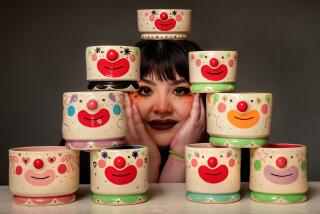Clowns Start Their Routines When Kids Start to Act Out
- Share via
BALTIMORE — When the youngsters at Downtown Baltimore Children’s Center tease one another too much, when their silliness spreads faster than chicken pox, when a few children resort to hitting or biting to settle their disagreements, the teachers don’t lecture, cajole or take away privileges.
They send in the clowns.
Not to laugh off behavioral problems, but to solve them or, better yet, to help the children solve them.
The clowns--teachers whom the children recognize behind their “white face”--act out the problem in mime, portraying it in a situation that the children can understand and letting them “write” a happy ending to the skit. The technique is called “mimesolving,” developed at Johns Hopkins University to give insight into undesirable behavior and how to change it.
Two or three clowns participate in a skit; a “facilitator,” who is not a clown, stops the action to get the children involved.
Mime Scenario
For instance, if a group of children is having a problem with too much teasing, here is what might happen:
Portraying a child, Clown 1 builds with blocks while Clown 2, playing another child, watches. Slowly, Clown 2 moves toward the other clown, making faces. Clown 1 ignores the other clown at first but gradually is distracted, looks hurt and begins to sulk. Then she looks sad and cries. Clown 2 continues teasing until Clown 1 looks angry and tries to hit Clown 2.
This is the peak of the conflict.
Now the children must finish the script by offering solutions. The facilitator, who has interrupted the action all along to ask questions such as “What do you think is happening?” and “How do you think the clowns are feeling?” will now ask “How do you think they can fix the problem?”
The clowns take their cues from the youngsters, acting out the proposed solutions until the children, with a little help from the facilitator, see one that really works.
The clowns are played by Nan Russell, a teacher at the center; Margo Shayne, program director, and Ann Scheck, director of Woods Memorial Child Development Center.
Emotional Level
The three shared their technique recently with educators at the annual conference of the National Association for the Education of Young Children in Anaheim.
In mime, “we bypass the verbal, cognitive level and it hits them at an emotional level. The children are sitting on the edge of their chairs the whole time and, in this way, they’re giving messages to themselves and alternative solutions are evolving in their own mind,” explained Russell, who developed the technique with Lee Richmond and Lenore Lynch at Hopkins and refined it with patients at The Kennedy Institute for sick and disabled children.
Through the mimes’ actions the children are able to bring their own thoughts and ideas to the situation.
The nature of the clown helps, too. “They don’t have a sex . . . they don’t have an age . . . so they’re kind of ambiguous,” Shayne said. “Each person in the audience can see what’s going on from his perspective. They can overlay their feelings, their emotions and their experiences on what the clown is doing.”
Focus on Behavior
“And, of course, they love the clowns,” said Russell, who is almost mystical about clowns and their power to draw people out.
She added, “the children identify with us much more strongly than with puppets,” another tool often used to portray behavioral problems to children.
In preschool, mime-solving is used to attack behavioral, rather than psychological, problems and to address situations common to many children in a classroom.
The long-term effects of all this clowning around are unknown, but for the short haul, mimesolving is effective in changing young children’s behavior, the educators say.
“The next day or the day after, if some children are in some kind of tension, someone will come up and say ‘remember the clowns.’ . . .And they’ll talk about it months later,” Russell said.
“It’s just simply a wonderful way of teaching children to teach themselves. It’s a pretty magic thing.”
More to Read
Sign up for Essential California
The most important California stories and recommendations in your inbox every morning.
You may occasionally receive promotional content from the Los Angeles Times.













